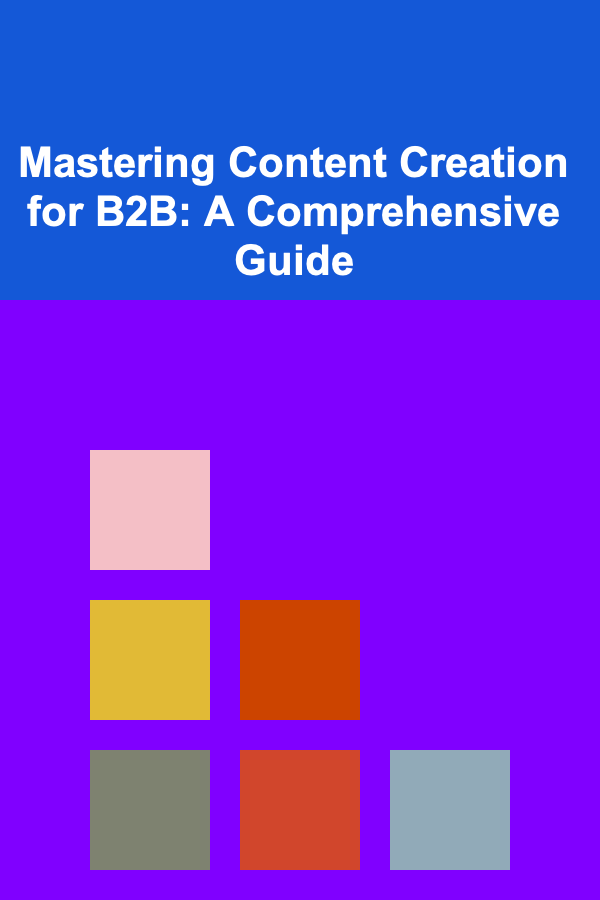
Mastering Content Creation for B2B: A Comprehensive Guide
ebook include PDF & Audio bundle (Micro Guide)
$12.99$10.99
Limited Time Offer! Order within the next:

In the complex and competitive landscape of B2B marketing, content creation stands as a critical pillar for success. Unlike B2C, where emotional appeals and broad marketing tactics often reign supreme, B2B demands a more nuanced and strategic approach. Decision-makers are typically highly informed, analytical, and focused on tangible value and ROI. Therefore, mastering content creation in the B2B space requires a deep understanding of your target audience, a commitment to providing valuable insights, and a consistent, well-planned strategy. This comprehensive guide will delve into the essential elements of crafting compelling B2B content that drives engagement, generates leads, and ultimately, closes deals.
I. Understanding the B2B Content Landscape
Before diving into the specifics of content creation, it's crucial to grasp the unique characteristics of the B2B market and how they influence content strategy.
A. The B2B Buyer Journey
The B2B buying process is typically longer, more complex, and involves multiple stakeholders compared to B2C. It can be broadly divided into several stages:
- Awareness: The buyer recognizes they have a problem or need.
- Consideration: The buyer researches potential solutions and defines their requirements.
- Decision: The buyer evaluates different vendors and makes a selection.
- Purchase: The transaction is finalized.
- Retention/Advocacy: The buyer becomes a loyal customer and potentially an advocate for your brand.
Understanding where your target audience is in this journey is paramount. Content should be tailored to address their specific needs and concerns at each stage. For example, awareness-stage content might focus on identifying pain points and offering high-level solutions, while decision-stage content should emphasize product features, benefits, and competitive advantages.
B. Knowing Your Audience: Developing Buyer Personas
Creating detailed buyer personas is a cornerstone of effective B2B content marketing. A buyer persona is a semi-fictional representation of your ideal customer, based on research and data about your existing and potential clients. Key elements of a buyer persona include:
- Demographics: Age, location, industry, company size, job title.
- Psychographics: Goals, challenges, motivations, pain points, values.
- Information Sources: Where do they get their information? (e.g., industry publications, conferences, online forums, social media).
- Buying Behavior: What is their role in the purchasing process? What factors influence their decisions?
Developing several distinct buyer personas will allow you to create more targeted and relevant content that resonates with different segments of your audience. Interview existing customers, analyze website data, and conduct market research to gather the information needed to build accurate and insightful personas.
C. The Importance of Value and Expertise
B2B buyers are primarily motivated by value and ROI. They need to be convinced that your product or service will solve their problems, improve their efficiency, or increase their profitability. Therefore, your content should be authoritative, insightful, and demonstrably valuable.
Establish yourself as a thought leader in your industry by sharing original research, offering expert opinions, and providing practical solutions to common challenges. Avoid overly promotional content that focuses solely on your products. Instead, focus on educating, informing, and empowering your audience.
II. Crafting Compelling B2B Content: Formats and Strategies
Once you have a solid understanding of your audience and the B2B content landscape, you can begin to create content that will capture their attention and drive results. Here are some of the most effective content formats for B2B:
A. Blog Posts
Blog posts are a versatile and cost-effective way to share your expertise, attract organic traffic, and generate leads. Focus on creating high-quality, informative content that addresses your target audience's pain points and provides valuable insights.
- How-to Guides: Provide step-by-step instructions on how to solve specific problems or achieve desired outcomes.
- Listicles: Offer a curated list of tips, resources, or best practices.
- Thought Leadership Articles: Share your unique perspective on industry trends and challenges.
- Case Studies: Showcase how your product or service has helped other businesses achieve success.
- Industry News and Analysis: Provide timely updates and insightful commentary on relevant industry developments.
Optimize your blog posts for search engines by using relevant keywords, writing compelling meta descriptions, and building internal and external links.
B. White Papers and eBooks
White papers and eBooks are longer-form content pieces that delve deeper into a specific topic. They are ideal for educating prospects about complex issues and positioning your company as a trusted authority.
- White Papers: Present in-depth research, analysis, and solutions to complex business problems. They typically focus on providing objective and unbiased information.
- eBooks: Offer a more comprehensive and engaging overview of a topic, often incorporating visuals and storytelling. They can be more promotional than white papers, while still providing substantial value.
These types of content are often gated behind a lead capture form, allowing you to collect valuable contact information from interested prospects.
C. Case Studies
Case studies are powerful tools for demonstrating the real-world value of your product or service. They tell the story of how you helped a specific customer overcome a challenge and achieve a positive outcome.
A compelling case study should include:
- The Challenge: Clearly describe the problem that the customer was facing.
- The Solution: Explain how your product or service addressed the challenge.
- The Results: Quantify the benefits that the customer achieved (e.g., increased revenue, reduced costs, improved efficiency).
- Quotes: Include quotes from the customer to add credibility and authenticity.
Use compelling visuals and a clear, concise writing style to make your case studies engaging and easy to understand.
D. Webinars
Webinars are an excellent way to engage with your audience in real time, provide valuable information, and generate leads. They offer an opportunity to interact directly with prospects, answer their questions, and build relationships.
To create a successful webinar, you should:
- Choose a relevant and compelling topic.
- Promote your webinar effectively.
- Deliver high-quality content.
- Engage with your audience through Q&A sessions and polls.
- Follow up with attendees after the webinar.
Record your webinars and make them available on demand to reach a wider audience.
E. Videos
Video is an increasingly popular content format for B2B marketers. It is engaging, informative, and easily shareable. Different types of video content can be leveraged for different stages of the buyer journey.
- Explainer Videos: Provide a brief overview of your product or service and its key benefits.
- Product Demos: Showcase how your product works and its features.
- Customer Testimonials: Feature satisfied customers sharing their experiences.
- Thought Leadership Videos: Share your expertise and insights on relevant industry topics.
Keep your videos short and to the point, and optimize them for search engines by using relevant keywords and creating compelling titles and descriptions.
F. Infographics
Infographics are a visually appealing way to present complex data and information in an easily digestible format. They are particularly effective for communicating statistics, trends, and processes.
When creating infographics, focus on:
- Choosing a relevant and compelling topic.
- Presenting data in a clear and concise manner.
- Using visually appealing graphics and design.
- Optimizing your infographic for sharing on social media.
G. Podcasts
Podcasts offer a convenient and engaging way for your audience to consume content on the go. They can be used to share your expertise, interview industry leaders, and discuss relevant topics.
To create a successful podcast, you should:
- Choose a niche topic that resonates with your target audience.
- Produce high-quality audio.
- Promote your podcast effectively.
- Engage with your listeners through social media and email.
III. Implementing a B2B Content Strategy: Planning and Execution
Creating compelling content is only half the battle. You also need a well-defined strategy for planning, executing, and promoting your content.
A. Defining Your Content Goals and Objectives
Before you start creating content, it's essential to define your goals and objectives. What do you want to achieve with your content marketing efforts? Common goals for B2B content marketing include:
- Generating leads: Attracting potential customers and capturing their contact information.
- Driving website traffic: Increasing the number of visitors to your website.
- Improving brand awareness: Increasing recognition and familiarity with your brand.
- Establishing thought leadership: Positioning your company as a trusted authority in your industry.
- Driving sales: Ultimately, converting leads into paying customers.
Make sure your goals are SMART (Specific, Measurable, Achievable, Relevant, and Time-bound).
B. Developing a Content Calendar
A content calendar is a schedule that outlines your planned content for a specific period, typically a month or a quarter. It helps you stay organized, maintain consistency, and ensure that your content aligns with your overall marketing goals.
Your content calendar should include:
- Content Title and Topic
- Content Format (e.g., blog post, eBook, video)
- Target Audience/Buyer Persona
- Keyword Focus
- Publication Date
- Distribution Channels
- Author/Responsible Party
Use a spreadsheet, project management software, or a dedicated content calendar tool to manage your content schedule.
C. Content Promotion and Distribution
Creating great content is not enough; you need to actively promote it to reach your target audience. Here are some effective content promotion and distribution strategies:
- Social Media: Share your content on relevant social media platforms. Tailor your message to each platform and use relevant hashtags.
- Email Marketing: Send your content to your email subscribers. Segment your list to ensure that your content is relevant to each recipient.
- Search Engine Optimization (SEO): Optimize your content for search engines to improve its visibility in search results.
- Paid Advertising: Use paid advertising platforms like Google Ads and LinkedIn Ads to reach a wider audience.
- Influencer Marketing: Partner with influencers in your industry to promote your content.
- Content Syndication: Republish your content on other websites and platforms to reach a new audience.
- Internal Linking: Link to your other relevant content within your blog posts and website pages.
D. Measuring and Analyzing Content Performance
It's crucial to track and analyze the performance of your content to determine what's working and what's not. Key metrics to track include:
- Website Traffic: The number of visitors to your website.
- Page Views: The number of times your content pages are viewed.
- Bounce Rate: The percentage of visitors who leave your website after viewing only one page.
- Time on Page: The average amount of time visitors spend on your content pages.
- Lead Generation: The number of leads generated from your content.
- Conversion Rate: The percentage of leads who convert into paying customers.
- Social Media Engagement: The number of likes, shares, and comments your content receives on social media.
Use analytics tools like Google Analytics and social media analytics dashboards to track these metrics. Regularly review your data and adjust your content strategy based on your findings.
IV. Best Practices for B2B Content Creation
Here are some additional best practices to keep in mind when creating B2B content:
A. Focus on Quality Over Quantity
It's better to create a few high-quality, valuable pieces of content than to churn out a large volume of mediocre content. Focus on providing insightful, well-researched, and engaging content that your audience will find genuinely helpful.
B. Write for Your Audience, Not for Yourself
Always keep your target audience in mind when creating content. Use language that they understand, address their specific pain points, and provide solutions that are relevant to their needs.
C. Use a Clear and Concise Writing Style
B2B buyers are busy professionals. They don't have time to wade through long, complicated sentences. Use a clear, concise, and direct writing style that gets straight to the point.
D. Incorporate Visuals
Visuals can make your content more engaging and easier to understand. Use images, videos, infographics, and other visuals to break up text and capture your audience's attention.
E. Optimize for Mobile
Many B2B buyers access content on their mobile devices. Make sure your content is optimized for mobile viewing by using a responsive design and ensuring that your images and videos are appropriately sized.
F. Proofread and Edit Carefully
Typos and grammatical errors can damage your credibility. Always proofread and edit your content carefully before publishing it.
G. Stay Up-to-Date with Industry Trends
The B2B landscape is constantly evolving. Stay up-to-date with the latest industry trends and incorporate them into your content.
V. The Future of B2B Content Creation
The future of B2B content creation is likely to be shaped by several key trends:
A. Increased Personalization
Buyers increasingly expect personalized experiences. Content will need to be tailored to the specific needs and interests of individual prospects and customers.
B. Greater Use of AI and Automation
AI and automation tools will play an increasingly important role in content creation, helping marketers to research topics, generate ideas, and optimize content for search engines.
C. More Interactive Content
Interactive content, such as quizzes, polls, and calculators, will become more popular as marketers seek to engage their audience in new and innovative ways.
D. Focus on Authentic Storytelling
B2B buyers are increasingly looking for authentic stories that resonate with their values and connect with them on an emotional level.
E. Emphasis on Building Communities
Building online communities around your brand will become increasingly important for fostering engagement, generating leads, and building customer loyalty.
Conclusion
Mastering content creation for B2B requires a strategic and disciplined approach. By understanding your audience, creating valuable content, implementing a well-defined strategy, and staying up-to-date with industry trends, you can create a content marketing program that drives engagement, generates leads, and ultimately, helps you achieve your business goals. Remember that content is not just about selling; it's about building relationships, establishing trust, and providing value to your audience. Embrace this mindset, and you'll be well on your way to mastering the art of B2B content creation.
Reading More From Our Other Websites
- [Hiking with Kids Tip 101] Kid-Friendly Hiking Hacks: From Packing to Safety on the Trail
- [Home Budget 101] How to Budget for Homeowners Association (HOA) Fees
- [Organization Tip 101] How to Create a Recipe Binder for Your Favorite Meal Prep Dishes
- [Personal Investment 101] How to Evaluate Risk Tolerance Before Making Investments
- [Personal Finance Management 101] How to Cultivate the Financial Habits of Successful People for Long-Term Wealth Building
- [Personal Care Tips 101] How to Effectively Use Teeth Whitening Strips for a Fast Whitening Boost
- [Home Staging 101] How to Achieve a Grand Entrance When Staging an Entryway in a Large Home
- [Home Rental Property 101] How to Identify Houses for Rent with a Built-In Sound System
- [Home Pet Care 101] How to Set Up a Pet-Friendly Bathroom for Easy Grooming
- [Organization Tip 101] How to Pack a Moving Day Survival Kit

How to Create a Checklist for Boosting Your Immune System Naturally
Read More
How to Host a DIY Family Talent Show
Read More
How to Use Gardening Skills to Make Money
Read More
How to Foster Blockchain Adoption
Read More
How to Refinance Personal Loans for Lower Interest Rates
Read More
10 Tips for Project Managers in the Tech Industry
Read MoreOther Products

How to Create a Checklist for Boosting Your Immune System Naturally
Read More
How to Host a DIY Family Talent Show
Read More
How to Use Gardening Skills to Make Money
Read More
How to Foster Blockchain Adoption
Read More
How to Refinance Personal Loans for Lower Interest Rates
Read More